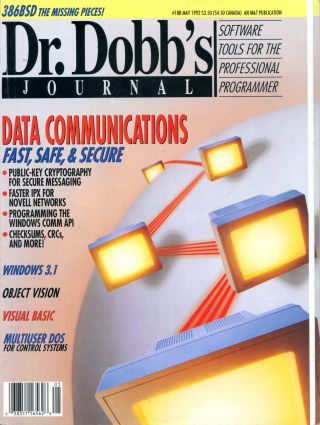
p.6 EDITORIAL
[author : Jonathan Erickson] #Edito
TABLE OF CONTENTS
FEATURES
p.16 UNTANGLING PUBLIC-KEY CRYPTOGRAPHY
[author : Bruce Schneier]
As we move into the world of electronic communication, the need for secure, private messaging becomes more and more important.
p.32 FLETCHER'S CHECKSUM
[author : John Kodis]
When it comes to high-speed data verification, Fletcher's checksum algorithm can do the job.
p.40 THE WINDOWS COMMUNICATIONS API
[author : Mike Sax]
Mike ports an XModem engine from DOS to Windows using Windows' Comm API facilities.
p.46 IPX: THE GREAT COMMUNICATOR
[author : Rahner James]
This library of IPX functions can significantly improve Novell network throughput.
p.54 PORTING UNIX TO THE 386: MISSING PIECES, PART 1
[author : William Frederick Jolitz and Lynne Greer Jolitz]
Over the next couple of months, we present the glue that lets you build an operational kernel.
p.64 FILE VERIFICATION USING CRC
[author : Mark R. Nelson]
Mark's implementation of the CRC-32 algorithm generates a unique 32-bit number.
EMBEDDED SYSTEMS
p.70 MULTIUSER DOS FOR CONTROL SYSTEMS: PART II
[author : Richard Kryszak]
Multiuser DOS from Digital Research is an MS-DOS compatible multitasking operating system that's a good platform for control systems.
EXAMINING ROOM
p.76 BRIDGING THE GAP WITH RESIDENT_C
[author : Charles Albert Mirho]
Here's a TSR that bridges the gap between DOS and real- or standard-mode Windows.
PROGRAMMER'S WORKBENCH
p.80 VISUAL BASIC AND WINDOWS 3.1 EXTENSIONS
[author : Moshe Lichtman]
Custom controls are central to Windows programming, particularly pencentric development.
COLUMNS
p.109 PROGRAMMING PARADIGMS
[author : Michael Swaine]
Michael takes a look at UserTalk, Frontier's C-like scripting language.
p.115 C PROGRAMMING
[author : Al Stevens]
The Application window class is the foundation of any D-Flat application.
p.123 STRUCTURED PROGRAMMING
[author : Jeff Duntemann]
To Jeff, Borland's Object Vision is really a Windows-based, event-driven programming language.
p.131 GRAPHICS PROGRAMMING
[author : Michael Abrash]
Michael opens his mail and finds alternative approaches to hidden surfaces, dual-monitor debugging techniques, bitblt "compiling," and more.
p.139 PROGRAMMER'S BOOKSHELF
[author : Ray Duncan]
If you're a serious programmer, Andrew Tanenbaum's books should find a place in your library.
DEPARTMENTS
p.8 LETTERS
[author : you]
p.160 SWAINE'S FLAMES
[author : Michael Swaine]
PROGRAMMER'S SERVICES
p.154 OF INTEREST
[author : Tami Zemel]
